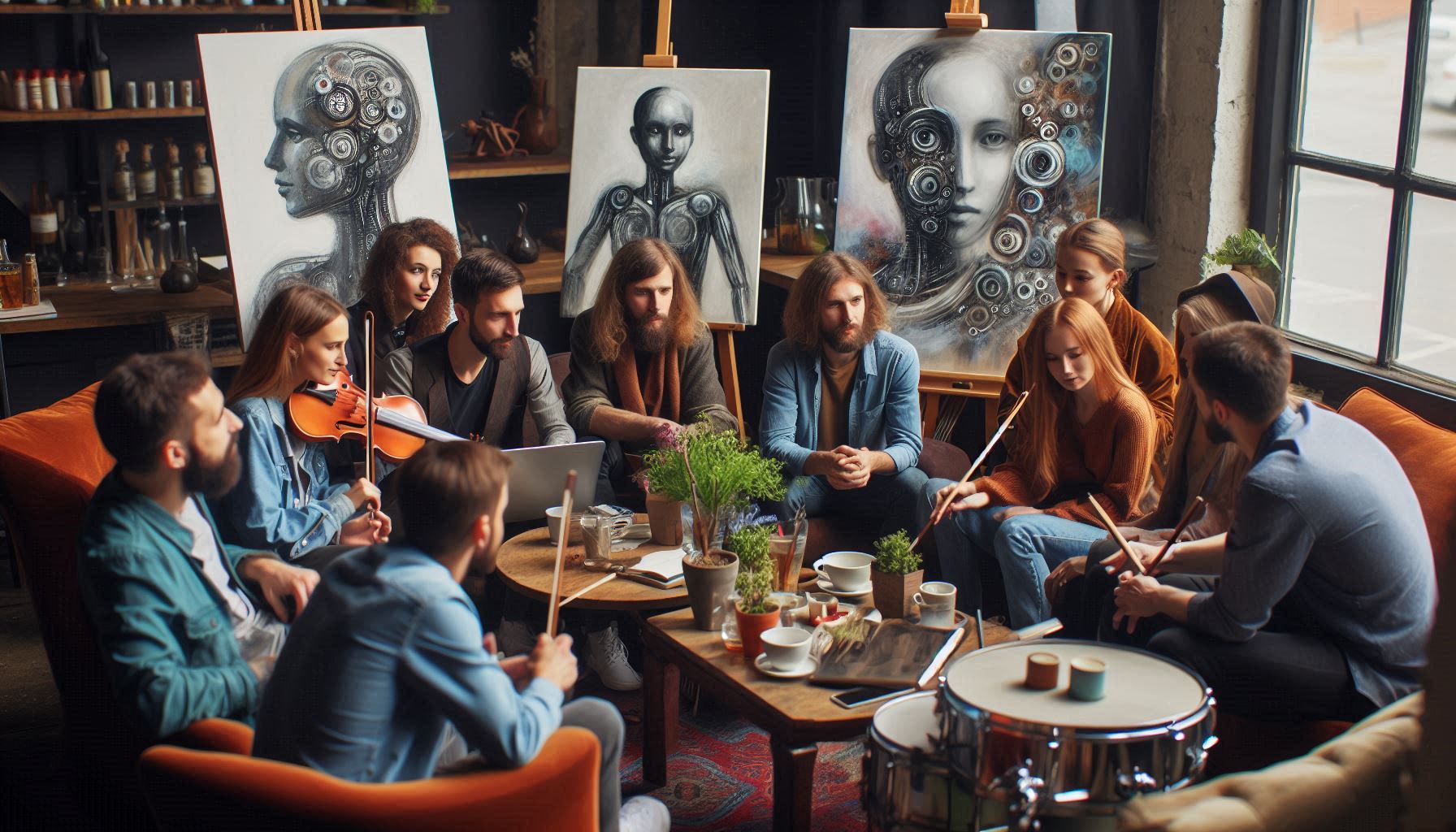Applications of Generative AI in Art and Music
 Fanny Nyayic
Fanny Nyayic
Generative AI, a subfield of artificial intelligence, is revolutionizing the creative industries, particularly in art and music. By leveraging algorithms and deep learning techniques, generative AI systems can produce novel and inspiring pieces, pushing the boundaries of human creativity.
Introduction
Generative AI refers to the use of algorithms and machine learning to create new content, such as images, music, and even text. Unlike traditional AI, which follows predefined rules, generative AI learns patterns and structures from large datasets to generate original outputs.
This capability has opened up new possibilities in the world of art and music, allowing artists and musicians to explore uncharted creative territories.
In this post, we'll delve into specific applications of generative AI in these fields, showcasing its potential and impact.
Generative AI in Visual Art
1. Creating Unique Artworks
Generative AI has enabled artists to produce unique and intricate artworks that might be difficult or impossible to create manually.
Using algorithms like Generative Adversarial Networks (GANs), artists can generate new images based on a dataset of existing artworks.
This process involves two neural networks: one generates images, while the other evaluates their quality. The result is a continuous improvement cycle, producing increasingly sophisticated pieces.
An example is the work of artist Mario Klingemann, who uses generative AI to create surreal portraits that blend traditional and digital art.
2. Style Transfer and Augmentation
Another significant application of generative AI in art is style transfer. This technique allows artists to apply the style of one image to another, creating a hybrid artwork that combines different visual elements.
For instance, an artist can take a photograph and apply the painting style of Van Gogh to it, resulting in a unique piece that merges photography with classic art styles.
This capability not only enhances creativity but also opens up new ways for artists to experiment and innovate.
3. Enhancing Creative Processes
Generative AI tools can also assist artists in their creative processes by providing inspiration and new ideas. Tools like DeepArt and DALL-E allow artists to input a concept or description and receive multiple generated images based on that input.
This can help artists overcome creative blocks and explore new directions in their work.
Moreover, these tools can be used to prototype ideas quickly, saving time and effort in the initial stages of the creative process.
Generative AI in Music
1. Composing Original Music
Generative AI has made significant strides in music composition, enabling the creation of original pieces without human intervention.
Algorithms like OpenAI's MuseNet and Google's Magenta can compose music in various styles and genres, from classical symphonies to contemporary pop songs.
These AI systems analyze vast amounts of musical data to understand patterns and structures, allowing them to generate coherent and harmonically pleasing compositions.
This capability is particularly useful for musicians seeking to experiment with new styles or produce background scores for multimedia projects.
2. Remixing and Mashups
In addition to composing original music, generative AI can also remix existing songs or create mashups of different tracks. AI-powered tools can analyze the elements of multiple songs and blend them seamlessly, producing new and exciting versions of familiar tunes.
This application is popular among DJs and music producers who want to create unique mixes for live performances or recordings.
The ability to automate the remixing process also speeds up production time, allowing artists to focus on other aspects of their craft.
3. Personalized Music Experiences
Generative AI is transforming how we experience music by enabling personalized playlists and compositions. AI algorithms can analyze an individual's listening habits and preferences to generate customized playlists that suit their tastes.
Additionally, AI systems can create original compositions tailored to specific moods or activities, such as workout sessions or relaxation.
This personalization enhances the listener's experience, making music consumption more engaging and enjoyable.
Collaborative Creativity with Generative AI
1. Human-AI Collaboration in Art
Generative AI is not just a tool for independent creation; it also facilitates collaboration between humans and machines. Artists can work alongside AI systems, using them as creative partners to explore new ideas and techniques.
For example, an artist might input a rough sketch into an AI tool, which then generates multiple variations and enhancements.
The artist can then select and refine the most promising outputs, resulting in a collaborative piece that combines human intuition with AI precision.
This synergy can lead to innovative artworks that neither humans nor machines could create alone.
2. Co-Creation in Music
Similarly, generative AI enables co-creation in music, allowing musicians to collaborate with AI systems to produce new compositions.
AI tools can generate melodies, harmonies, and rhythms based on a musician's input, providing a starting point for further development.
This collaborative approach can spark creativity and inspire musicians to explore new musical directions.
For instance, the band YACHT used AI to generate parts of their album "Chain Tripping," blending human and machine creativity to produce a unique sound.
Ethical Considerations and Future Directions
1. Addressing Ethical Concerns
While generative AI offers exciting possibilities, it also raises ethical concerns that need to be addressed. One major issue is the potential for AI-generated content to infringe on intellectual property rights.
For example, if an AI system generates a piece of music that closely resembles an existing song, it could lead to legal disputes over authorship and copyright.
To mitigate these risks, it's essential to establish clear guidelines and regulations around the use of generative AI in creative industries.
2. The Future of Generative AI in Art and Music
Looking ahead, the future of generative AI in art and music is bright, with ongoing advancements promising even more sophisticated and creative applications.
As AI systems continue to improve, we can expect to see more seamless integration of AI-generated content into mainstream art and music. Furthermore, new tools and platforms will emerge, making generative AI more accessible to artists and musicians worldwide.
This democratization of technology will enable a broader range of creative voices to experiment and innovate, leading to a more diverse and vibrant cultural landscape.
Conclusion
Generative AI is transforming the fields of art and music, offering new tools and opportunities for creativity. From generating unique artworks to composing original music, this technology is pushing the boundaries of what is possible.
As we continue to explore the potential of generative AI, it's crucial to address ethical concerns and ensure that this technology is used responsibly.
I invite you to share your thoughts and experiences with generative AI in the comments below.
Subscribe to my newsletter
Read articles from Fanny Nyayic directly inside your inbox. Subscribe to the newsletter, and don't miss out.
Written by

Fanny Nyayic
Fanny Nyayic
a passionate web developer, tech writer, open-source contributor & a life long learner.